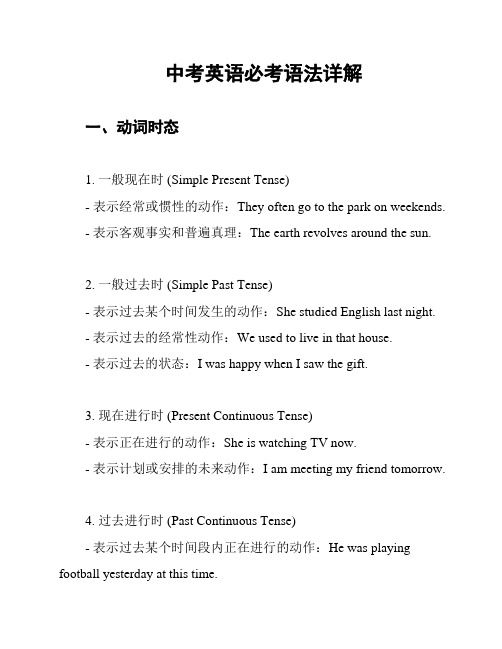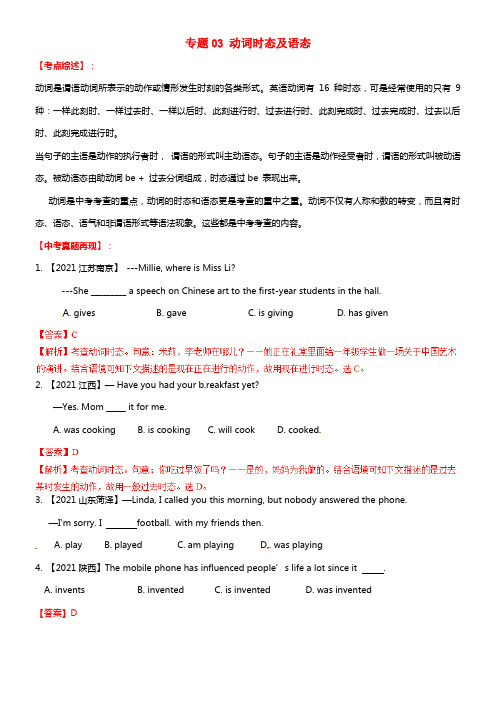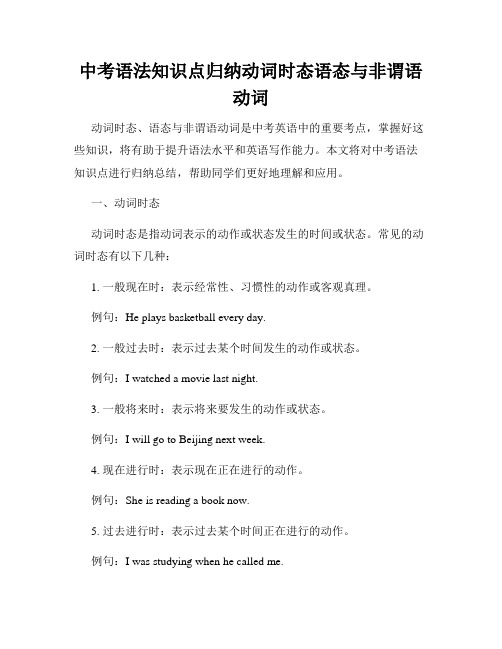2021届新中考英语冲刺备考复习--动词时态区分
中考英语必考语法详解

中考英语必考语法详解一、动词时态1. 一般现在时 (Simple Present Tense)- 表示经常或惯性的动作:They often go to the park on weekends.- 表示客观事实和普遍真理:The earth revolves around the sun.2. 一般过去时 (Simple Past Tense)- 表示过去某个时间发生的动作:She studied English last night.- 表示过去的经常性动作:We used to live in that house.- 表示过去的状态:I was happy when I saw the gift.3. 现在进行时 (Present Continuous Tense)- 表示正在进行的动作:She is watching TV now.- 表示计划或安排的未来动作:I am meeting my friend tomorrow.4. 过去进行时 (Past Continuous Tense)- 表示过去某个时间段内正在进行的动作:He was playing football yesterday at this time.5. 现在完成时 (Present Perfect Tense)- 表示过去发生的与现在有联系的动作或状态:He has already finished his homework.6. 过去完成时 (Past Perfect Tense)- 表示过去某个时间点之前已经发生的动作或状态:She had already left when I arrived.7. 将来时 (Future Tense)- 表示将来要发生的动作或存在的状态:I will go to Beijing next week.二、被动语态1. 被动语态的构成:be + 过去分词- 主动语态:Tom eats an apple.- 被动语态:An apple is eaten by Tom.2. 被动语态的使用:- 强调动作的承受者:The book is written by a famous author.- 不知道或没有必要知道动作的执行者:The door was broken yesterday.三、情态动词1. can / could- 表示能力或许可:I can swim very well.- 表示请求或建议:Could you open the window, please?2. may / might- 表示允许或可能:You may go home now.3. must- 表示必须或肯定:She must finish her assignment by tomorrow.4. shall / should- 表示将要或应该:We should keep the classroom clean.四、倒装句1. 把助动词或情态动词提前,主语放在动词之后:- Never have I seen such a beautiful sunset.- Only after he left did I realize my mistake.2. 用于表示地点、方向、时间等状语提前:- At the top of the mountain stands a little cottage.- In front of the house is a beautiful garden.五、定语从句1. 定语从句用来修饰一个名词或代词,用以给出更多的信息。
2021届全国新高考英语冲刺备考:动词时态

动词时态
一、动词的定义
二、动词的分类 (1) (2) (3) 三、动词的时态 1.一般现在时 2.一般过去时
3.一般将来时 4.过去将来时 5.现在进行时 6.过去进行时
7.现在完成时 8.过去完成时
9.将来进行时 10.将来完成时 11.现在完成进行时
四、非谓语动词
常与连词:when , as soon as , before , after , until , if 如果,等引导的 时间状语或条件状语从句
练习 返回
The baby is generally healthy, but every now and then he ______ a cold.
A. has caught B. is catching C. will catch D. does catch
I ______ ping-pong quite well, but I haven’t had time to play since the New Year.
A. will play B. have played C. played D. play
eg.The sun rises in the east. Light goes faster than sound
(4)用于状语从句代替一般将来时 eg.You will succeed if you try .
I will tell him about it as soon as I see him next Monday.
返回
三、按动词的形式可以分为谓语动词和非谓语动词
1、谓语动词(如下)
2、非谓语动词
形式
意义
与主语在人称一致 人称
中考重点动词时态与语态的辨析与运用

中考重点动词时态与语态的辨析与运用一、动词时态的辨析与运用动词时态是指动作或状态发生的时间,包括一般现在时、一般过去时、一般未来时等。
在中考中,正确选择动词时态能够准确表达句子的意思,展现语言运用的能力。
1. 一般现在时(Simple Present Tense)一般现在时表示经常性、习惯性或客观事实。
在题目中,我们需要根据上下文来判断使用一般现在时。
如:- Amy often goes to school by bus.(Amy经常乘公交车去学校。
)- Water boils at 100 degrees Celsius.(水在100摄氏度时沸腾。
)2. 一般过去时(Simple Past Tense)一般过去时表示过去发生的动作或状态。
通常是在谈论已经结束或发生在过去的事情。
如:- Yesterday, I visited my grandparents.(昨天,我去看望了我的祖父母。
)- He lived in Paris for five years.(他在巴黎住了五年。
)3. 一般将来时(Simple Future Tense)一般将来时表示将来会发生的动作或状态。
如:- We will go to the movies this weekend.(我们这个周末将去看电影。
)- She is going to travel to Europe next month.(下个月她将去欧洲旅行。
)4. 现在进行时(Present Continuous Tense)现在进行时表示现在正在进行的动作,或者表示将来已经安排好的计划。
如:- They are playing basketball in the park now.(他们正在公园里打篮球。
)- We are meeting at the library tomorrow.(我们明天在图书馆开会。
)5. 过去进行时(Past Continuous Tense)过去进行时表示过去某个时间正在进行的动作。
中考英语备考 专题03 动词时态及语态(含解析)

专题03 动词时态及语态【考点综述】:动词是谓语动词所表示的动作或情形发生时刻的各类形式。
英语动词有16种时态,可是经常使用的只有9种:一样此刻时、一样过去时、一样以后时、此刻进行时、过去进行时、此刻完成时、过去完成时、过去以后时、此刻完成进行时。
当句子的主语是动作的执行者时,谓语的形式叫主动语态。
句子的主语是动作经受者时,谓语的形式叫被动语态。
被动语态由助动词be + 过去分词组成,时态通过be 表现出来。
动词是中考考查的重点,动词的时态和语态更是考查的重中之重。
动词不仅有人称和数的转变,而且有时态、语态、语气和非谓语形式等语法现象。
这些都是中考考查的内容。
【中考真题再现】:1. 【2021江苏南京】---Millie, where is Miss Li?---She _________ a speech on Chinese art to the first-year students in the hall.A. givesB. gaveC. is givingD. has given2. 【2021江西】— Have you had your b reakfast yet?—Yes. Mom _____ it for me.A. was cookingB. is cookingC. will cookD. cooked3. 【2021山东菏泽】—Linda, I called you this morning, but nobody answered the phone.—I'm sorry. I football with my friends then.A. playB. playedC. am playingD. was playing4. 【2021陕西】The mobile phone has influenced people’s life a lot since it .A. inventsB. inventedC. is inventedD. was invented【答案】D【解析】考查动词时态及语态。
2021届新中考英语冲刺精品备考 动词的时态和语态

8.(2019·新疆) It is _r_a_i_n_i_n_g_ (rain) hard outside.Take an umbrella with you. 9.(2019·北部湾)In the playground, I threw the ball to her and she _c_a_u_g_h_t__ (catch) it. 10.(2019·青岛)The writer is so popular that he __h_a_s__s_o_l_d___ (sell) more than 200,000 books so far. 11.(2019·贵阳)The best things in life __a_r_e____ (be) free, like smiles, love and good memories.
(4)one day,in the (near) future
时态
常见用法及例句
(1)表示将来发生的动作或存在的状态。如:
They are leaving for Shanghai next week.
一般 (2)be going to+动词原形,表示计划、打算做某事,表示已决
将来 定的、很可能发生的事,或有某种迹象表明要发生的事。如:
时 What are you going to do next Sunday?
Look at the dark clouds.There is going to be a storm.(客
观迹象)
时态
常见用法及例句
(3)be doing 表示将来,常用这种结构的动词有 go,come,leave,
2.—(2020·常德)What is he doing? —He __i_s__u_s_i_n_g___ (use) the computer.
中考语法知识点归纳动词时态语态与非谓语动词

中考语法知识点归纳动词时态语态与非谓语动词动词时态、语态与非谓语动词是中考英语中的重要考点,掌握好这些知识,将有助于提升语法水平和英语写作能力。
本文将对中考语法知识点进行归纳总结,帮助同学们更好地理解和应用。
一、动词时态动词时态是指动词表示的动作或状态发生的时间或状态。
常见的动词时态有以下几种:1. 一般现在时:表示经常性、习惯性的动作或客观真理。
例句:He plays basketball every day.2. 一般过去时:表示过去某个时间发生的动作或状态。
例句:I watched a movie last night.3. 一般将来时:表示将来要发生的动作或状态。
例句:I will go to Beijing next week.4. 现在进行时:表示现在正在进行的动作。
例句:She is reading a book now.5. 过去进行时:表示过去某个时间正在进行的动作。
例句:I was studying when he called me.6. 现在完成时:表示过去的动作对现在造成的影响或结果。
例句:She has visited Paris three times.7. 过去完成时:表示对过去某个时间之前发生的动作进行的描述。
例句:They had already left when I arrived.二、动词语态动词语态是指动作发出的主体和动作所受的影响关系。
英语中常见的动词语态有以下几种:1. 主动语态:表示主语是动作的发出者。
例句:He fixed the car yesterday.2. 被动语态:表示主语是动作的承受者。
例句:The car was fixed by him yesterday.3. 进行时态:表示主语正在进行的动作处于进行状态。
例句:The book is being read by her.4. 完成时态:表示主语已经完成的动作处于完成状态。
例句:The book has been read by her.注意:被动语态需要根据动作的时态来变换,同时需要适当更改时态动词。
2021年中考英语语法复习动词专题

语法专项复习动词考点一:动词一、动词分类及物动词长动词(延续性动词)/实义动词不及物动词短动词(短暂性动词)be动词系动词:_______________________________(5个)表示主语变化/不变的动词do, does, did, will, would, shall, shouldcan, could, may. might, should, must, need二、动词的基本形式五种:do—does—did—done—doing1.动词的原型,主要用于___________________时态2.动词的三单,主要用于__________________时态①直接在词尾加-s play--_________②以字母-s, -x, -ch, -sh, -o结尾的在词尾加–es wash---________, go---_______③以辅音字母+y结尾的,去y变i加-es fly---_______, cry---______3.动词的过去式,主要用于________________时态①直接在词尾加-ed plant---________②以e结尾的, 加-d change---________③重读闭音节最后只有一个辅音字母结尾,双写这个辅音字母再加-ed plan-_______④以“辅音字母+y”结尾的,变y为i加-ed try---________⑤不规则变化see---_______, buy---_______见英语书后的附录4.动词的过去分词,主要用于________________时态,__________语态和_____________The boy called Tom is my brother.go—went—_______, forget-forgot-_________, teach-taught-_________5.动词的现在分词,主要用于___________时态和_____________Children throw snowballs to each other, screaming and laughing.The boy waiting at the door is my brother.①直接在词尾加ing, seeing②去e加ing, take-taking③重读闭音节最后只有一个辅音字母结尾,双写这个辅音字母再加ing put-putting④以ie结尾,去ie为y再加ing die-dying, tie-tying, lie-lyingbegin/startend/finishdiecatch a coldbecome interested inget marriedjoinleavearrive/reach关键是:瞬间动词不能和表达一段时间的状语连用。
2021届新中考英语冲刺精品备考 动词的时态

1.一般将来时的构成。 (1)will+动词原形(主语是第一人称时也可用shall+动词原形) 句式结构为: 肯定句式:主语+will (shall)+动词原形 She will call you this evening. 她今天晚上会给你打电话。
否定句式:主语+will (shall)+not+动词原形 She won’t have time to play with you. 她没有时间和你玩。 疑问句式:Will (Shall)+主语+动词原形
1.句式结构 肯定句式:主语+动词过去式 否定句式:主语+助动词didn’t+动词原形 疑问句式:助动词Did+主语+动词原形
She did some washing this morning. 今天早晨她洗了一些衣服。 否定式:She didn’t do any washing this morning. 疑问式:Did she do any washing this morning?
【巧学妙记】 一般现在时用法口诀
学习一般现在时,基本用法要熟悉。 表示动作常发生,特征性格和能力。 存在状态和习惯,客观事实与真理。 如果主语是单三,谓语就要变一变。
【考点专练】
( C )1.(2020甘肃武威中考)I want a mobile phone which
good pictures.
to a bright future.
A.has
B.have
C.will have D.had
考点2一般过去时 一般过去时的构成和用法
一般过去时表示过去某个时间进行的动作或存在的状态,多 与时间状语yesterday,last,night,ago,just now,the other day, once upon a time,when she was young等连用。
初中英语中考复习 秘籍04 动词的时态和语态-2021年中考英语抢分秘籍(解析版)

5.过去完成时与现在完成时的主要区别是时间参照点不用:过去完成时的时间参照点是某个“过去的”时间;现在完成时的时间参照点是“现在”。在使用时,还要注意现在完成时中的很多规则,也适用于过去完成时。
时间状语有:yesterday,last week,an hour ago,the other day,in 1981等。
Where did you go just now?刚才你去哪儿了?
2.表示在过去一段时间内,经常性或习惯性的动作。特别是由would / used to表达的句型,本身表达的就是过去时。常与always,usually,often,sometimes,never等时间状语连用。
1.表示过去某一时刻正在进行的动作,这一特定的时间或时刻除了上下文暗示之外,还有时间状语如at that time / moment,at this time yesterday或when / while等引导的状语从句表示。
What were you doingat nine o’clock yesterday evening?
When I was a child, I oftenplay footballin the yard.
3.用于追述逝去的人或事,以及在从句中叙述历史事实。
Our teacher told us that Columbus discovered America in 1492.
4.用于虚拟语气(非真实的过去)。
If Iknowthe truth, I would tell you now.
5.辨析used to / be used to
初中英语知识总结——动词时态的区别与用法

初中英语知识总结——动词时态的区别与用法动词时态是英语语法中重要的组成部分,不仅可以帮助我们表达不同的时间和状态,还可以使我们的语言更加准确和具有时效性。
对于初学者来说,了解动词时态的区别与用法非常重要。
在本文中,我将总结初中阶段英语中常见的动词时态,包括一般现在时、一般过去时、一般将来时以及现在进行时。
一般现在时:一般现在时用于描述经常性的行为或者客观事实。
我们可以用这种时态来介绍自己的爱好、描述固定的时间表或者谈论普遍真理等。
例如:1. I usually go swimming on weekends. (我通常在周末去游泳。
)2. John plays the piano very well. (约翰弹钢琴弹得很好。
)3. Water boils at 100 degrees Celsius. (水在100摄氏度沸腾。
)一般过去时:一般过去时用于描述过去发生的事情。
它需要使用动词的过去式形式,无论主语是单数还是复数。
例如:1. Last night, I watched a movie with my friends. (昨晚,我和朋友们一起看电影。
)2. They visited their grandparents during the summer vacation. (暑假期间,他们去拜访了他们的祖父母。
)3. She cooked a delicious meal for dinner yesterday. (昨天她为晚餐做了一顿美味的饭菜。
)一般将来时:一般将来时用于表达将来要发生的事情或者对未来的预测。
通常情况下,我们可以使用助动词will或be going to来构成这种时态。
例如:1. I will travel to Japan next month. (下个月我将去日本旅行。
)2. We are going to have a party on Saturday. (星期六我们将举办聚会。
2021年中考英语复习---动词时态专项讲解-课件

在动词后加-ed
want
以字母e 结尾的动 词,只+d
“ 辅音字母+y ” , 变y 为i, 再+ed
重读闭音节以一个 辅音字母结尾的, 双写+ed
answer move
die carry
cry stop
plan
wanted answered moved died carried cried stopped planned
主+ have / has +PP
用法
例句
表示过去发生 1. I _ lunch yet. I am so hungry.
的动作对现在 造成的影响.
(sleep). 4. --- Were the children playing games on the
playground at 4:00 yesterday afternoon? --- No. But they _a_r_e_p__la_y_i_n_g_ (play) games there now. 5. The twins _w__e_re__d_o_in__g_ (do) his homework when their father came in.
过去进行时: Past Progressive 概念: 表示过去具体的某个时刻 正在发生的动作 结构: be (was,were) + doing 标志语:at 8:00 yesterday 、at this time yesterday 、when、 while、…
练习三 1. Look! The children _a_r_e_s_w__im__m__in_g__ (swim)
Sinking Ship last night? st summer we _w_e_n__t (go) to Qingdao
2021年中考英语复习--动词时态 专项讲解课件

bears
watch a movie/
drink beer
have a barbecue
动词的时态
一、一般现在时
二、一般过去时
三、一般将来时一般现在四时、过去将来时 五、现在进行时一般现在时六、过去进行时
七、现在完成时 八、过去完成时
判断句子的时态
1. I am a student.
一般现在时
2. Did you go shopping yesterday? 一般过去时
一般现在时:
主语+be+其他. 主语+动词原型+其他.
三单主语+动词s/es+其他
主语是第三人称单数时,谓语动词也得相应地变成第三人称单数。
规则
动词原形 第三人称单数形式
一般在词尾加-s
play leave swim
plays leaves swims
以字母s, x, ch, sh, o 结尾的词加-es
pass fix teach wish do
passes fixes teaches wishes does
以辅音字母加y结尾的 词,先变y为i, 再加
-es
study carry
fly
studies carries
flies
注意:动词have的第三人称单数形式是has
一般现在时:
将以下动词变三单
The Rabbit And The Turtle
• One day, a turtle _w_a_s_ climbing. A rabbit __s_a_w_(see) the turtle. It a_s_k_e_d_(ask) the turtle: “Hi, turtle. What __a_r_e_ you doing?” “I’m r_u_n_n_in_g_(run).” The turtle __s_a_id___(say). “Haha, you are running? How slowly! Let’s have a race. Let’s see who _r_u_n_s_(run) faster.” The rabbit _la_u_g_h_e_d__(laugh) at the turtle. The turtle said, “OK.
2021中考英语二轮复习 语法突破十一 动词的时态与语态考点剖析(讲义,五四制)

五四语法十一动词的时态与语态语法考点剖析中考需要掌握的时态和语态分别是:一般现在时及其被动语态、一般过去时及其被动语态、一般将来时及其被动语态、现在进行时、过去进行时、现在完成时、含情态动词的被动语态。
考点一动词的时态1.一般现在时。
表示经常性、习惯性的动作,常与often, usually, always等时间状语连用,表示客观真理。
She often works at the week end.她经常在周末工作。
There are four seasons in a year.一年有四季。
2.一般过去时。
表示过去发生的动作;be动词的一般过去时为was, were,实义动词的一般过去时为动词的过去式。
常与just now, yesterday, last week, ago等表示过去时间的状语连用。
Who did you see at the meeting yesterday?昨天的会议上你看见了谁?3.一般将来时。
由“shall/will+动词原形”构成,shall用于第一人称,will用于各种人称;此外还有“be going to+动词原形”的形式。
常与tomorrow, next week等表示将来的时间状语连用。
I am going to stay for a week.我打算待一个星期。
Look at the dark clouds. It is going to rain.看那乌云,要下雨了。
★be going to do表示将来是指事先经过考虑的打算或有迹象表明要发生某事。
4.现在进行时。
由“am/is/are+现在分词”构成,表示现在正在发生的事情或近期一直在做的事情。
句中常有now, look, listen等标志词。
Look! A bird is flying in the sky.看!一只鸟在天上飞。
She is teaching at a night school now.现在她在一所夜校教学。
- 1、下载文档前请自行甄别文档内容的完整性,平台不提供额外的编辑、内容补充、找答案等附加服务。
- 2、"仅部分预览"的文档,不可在线预览部分如存在完整性等问题,可反馈申请退款(可完整预览的文档不适用该条件!)。
- 3、如文档侵犯您的权益,请联系客服反馈,我们会尽快为您处理(人工客服工作时间:9:00-18:30)。
D. Had; seen; saw
(C) 2.I_n_t_h_e_la_s_t_fe_w__y_ea_rs, great changes____
in Tacheng.
A. take place
B. took place
C. have taken place
D. have been taken place
根据汉语意思把下列句子补充完整
1.飞机将__在_明__早6:30起飞。 The plane_w_i_ll_t_a_k_e__o_ff_____ at 6:30
tomorrow morning.
2.自__从_2_0_0_0年我们一直住在这里。 We __h_a_v_e__l_iv_e_d___ here since 2000. 3. _这_些__天_我们在植树。 We_a__re__p_l_a_n_ti_n_g_ trees these days.
• 5.The earth goes around the sun. • sk week Tom made a model
plane with his friend Jack. • 7.I often go to school by bike. • 8.Have you found your lost pen
2021届新中考英语冲刺备考复习
动词时态区分
试一试 任务一:将下列句子按时态分类
• 1.She has had the book for two days.
• 2.What were you doing at ten o’clock last night?
• 3.Fish will die without water. • 4.Listen, she is singing in the room.
选数字,闯关啦!
1 23
4
5
6
• 选择题(共20分)
( A) 1.--Tom,____you e_v_er ____that new film?
--Yes. I _____ it a week a_g_o.
A. Have; seen; saw B. Have; seen; see
C. Do; see; see
时间状语:already, just, yet, recently, before,
ever, never, twice, three times
B.从 __过__去___ 某一时刻开始一直持续到_现__在__的 _动__作___或__状__态___。
时间状语:
for, since, so far, in the last/past few years, ever, before 结构: have/has + 动词的过去分词
• 时间状语:
at that time, at this time yesterday, at nine o’clock yesterday, when, while, from nine to ten,
六、现在完成时
• 用法:A. 表示_过__去__发___生__的__动___作__对__现__在___造__成_ 的 ___影__响___和__结__果__。
• 12.Is Mike playing the piano in the room now?
怎样区分时态
看 时间状语 看 动词
任务二:回顾各时态的用法、结构及时间状语。
一 般 现 在 时
一
一
般
般
过
将
去
来
时
时
现
过
现
在
去
在
进
进
完
行
行
成
时
时
时
一、一般现在时
• 用法:A.表示_经__常__性__或__习__惯__性__ 的动作或
用所给词的适当形式填空
1._S_o_m_e_t_im__e_s Lucy__w_a_s_h_e_s__( wash) her clothes herself. 2. He __w_a_s__re_a_d_i_n_g___(read) _w_h_e_n I _c_a_m_e in. 3. When I _w_a_s in the countryside, I often__s_w_a_m______ (swim) in the river.
三、一般将来时
• 用法: 表示__将__来_____ 的动作或状态 • 结构: will/shall +v.
be going to +v.
时间状语:
tomorrow, the day after tomorrow, in (the) future, next week/month/term…, from now on, in a month (in+时间段), soon…
二、一般过去时
• 用法:表示过__去__发__生___的__动_作或_存__在__的__状__态
• 结构:be
was/were
v.
v.-ed
• 时间状语:
yesterday, three days ago,
last night /week/month, in the past,
a moment ago, just now, in 2008
yet?
• 9.There is going to be a basketball game next Friday.
• 10.I was doing my homework while my parents were watching TV.
• 11. I got up at six this morning.
四、现在进行时
• 用法:A.表示:现__在__正__在_进__行__的动作 B.表示_现__阶__段__的_动__作_
结构:am/is/are + v.-ing
• 时间状语:
now, look, listen,
at the moment
五、过去进行时
• 用法:表示_过__去__某__时__正__在__发__生__的__动__作_ • 结构:was/were + v.-ing
存在的状态
B.客观事__实___和真__理___
• 结构:beam/is/rev. (主语三单)v.-s/-es
• 时间状语:
always, usually, often, sometimes,
never, on Sundays,
every day/week/month/year/…,
once a week, every five minutes
